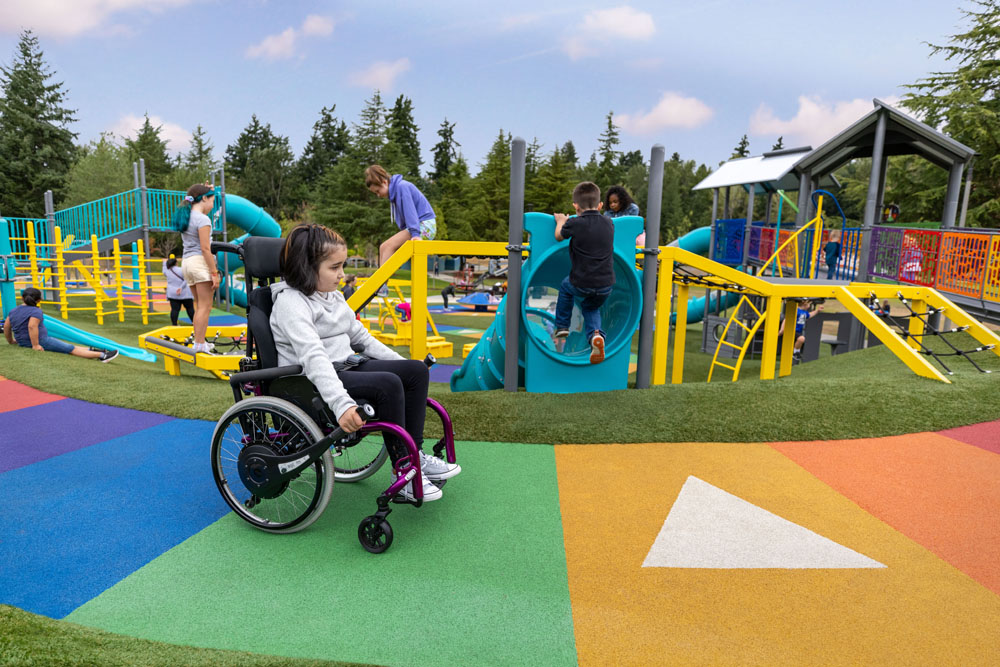Outdoor play is essential for childhood growth. It enhances physical development, fosters creativity, improves problem-solving, and encourages social skills. For schools and daycares, selecting the right outdoor play equipment means creating safe, engaging spaces that meet the needs of different age groups — from curious toddlers to energetic school-aged children.
Modern playgrounds are more than just slides and swings. They combine imaginative design, durability, inclusivity, and safety to deliver enriching outdoor experiences. Below are the best outdoor play equipment options for educational environments, along with insights into how to choose durable and developmentally appropriate installations.
1. Climbing Equipment
Why It Matters:
Climbing equipment builds strength, coordination, and confidence. It encourages children to assess challenges, plan movements, and develop motor control.
Popular Options:
- Climbing walls: Compact and challenging for older children.
- Rope climbers and cargo nets: Develop balance and grip strength.
- Dome climbers: Foster teamwork and spatial awareness.
- Vertical towers: Combine climbing with slides for added excitement.
Climbers are staples in both daycare and school settings, promoting physical endurance and mental focus.
2. Slides
Why It Matters:
Slides are a playground classic for a reason — they’re exciting, confidence-boosting, and help develop core stability and balance.
Slide Varieties:
- Straight slides: Great for younger children.
- Wave and spiral slides: Add movement variety for older students.
- Double slides: Allow children to slide side-by-side, encouraging social play.
When installed with proper safety surfacing, slides remain one of the most engaging and durable outdoor equipment choices.
3. Swings
Why It Matters:
Swings develop rhythm, coordination, and spatial awareness while offering a soothing, sensory experience for children.
Types of Swings:
- Belt swings: Standard and durable for older kids.
- Bucket swings: Supportive and safe for toddlers.
- Inclusive swings: Designed for children with limited mobility.
- Multi-user swings: Promote cooperative play and communication.
Schools and daycares benefit from installing mixed swing sets to accommodate multiple ages safely.
4. Multi-Activity Play Systems
Why It Matters:
Integrated play systems combine climbing, sliding, balancing, and crawling — creating diverse and continuous play experiences.
Common Features:
- Platforms and decks: Encourage exploration.
- Ramps and bridges: Support active movement and social interaction.
- Slides and tunnels: Add excitement and variety.
- Age-appropriate design: Custom sections for toddlers and older children.
These modular structures maximize space efficiency and provide long-lasting engagement for large groups.
5. Balance and Coordination Equipment
Why It Matters:
Balance-focused play enhances concentration, control, and lower-body strength. It also teaches children about body awareness and confidence.
Equipment Options:
- Balance beams: Encourage careful movement and stability.
- Seesaws: Promote cooperation and rhythm.
- Spring riders: Great for imaginative and physical play for younger kids.
- Spinners: Improve balance and sensory integration.
Adding motion-based play equipment gives children multiple ways to challenge their coordination safely.
6. Sensory and Imaginative Play Panels
Why It Matters:
Sensory play stimulates creativity, problem-solving, and fine motor skills. It’s particularly beneficial for early learners and children with sensory processing needs.
Examples:
- Musical panels: Drums, chimes, and xylophones encourage auditory exploration.
- Tactile panels: Provide textures for sensory feedback.
- Themed panels: Market stalls, steering wheels, and activity boards inspire role play.
Sensory equipment enhances cognitive growth while supporting inclusive learning environments.
7. Natural and Themed Play Structures
Why It Matters:
Nature-inspired equipment connects children with the outdoors and encourages imaginative play. These structures often blend into park or school landscapes beautifully.
Options:
- Treehouse-style towers: Encourage adventure and exploration.
- Rock climbers: Simulate natural climbing environments.
- Wood-look structures: Offer a warm, organic aesthetic.
- Eco-friendly materials: Use recycled or sustainable components.
Themed play encourages storytelling, cooperation, and creative thinking among students.
8. Inclusive and Accessible Play Equipment
Why It Matters:
Inclusive playgrounds ensure every child — regardless of physical or cognitive ability — can play, learn, and interact.
Key Inclusive Features:
- Ground-level activities: Panels, musical stations, and sensory zones.
- Accessible ramps and transfer platforms: Enable wheelchair access.
- Adaptive swings and spinners: Offer support and safety.
- Smooth, rubberized surfacing: Provides barrier-free mobility.
Inclusivity transforms outdoor spaces into community-centered environments where everyone feels welcome.
9. Outdoor Fitness and Challenge Courses
Why It Matters:
Older children and adolescents need higher physical challenges to stay active and engaged. Outdoor fitness equipment bridges the gap between playgrounds and physical education.
Common Elements:
- Monkey bars and ring tracks: Build upper-body strength.
- Climbing ropes: Encourage endurance and grip control.
- Balance boards: Develop agility and coordination.
- Obstacle courses: Inspire competition and teamwork.
Schools can integrate these into PE programs, promoting fitness while keeping play exciting.
10. Safety and Surfacing Essentials
Why It Matters:
No playground is complete without proper surfacing and safety zones. Impact-absorbing materials protect children from injuries and extend equipment life.
Recommended Surfaces:
- Poured-in-place rubber: Long-lasting and wheelchair-friendly.
- Rubber tiles: Modular and low-maintenance.
- Engineered wood fiber (EWF): Economical and natural-looking.
- Artificial turf: Clean, durable, and soft underfoot.
Surfaces should comply with ASTM and CSA safety standards for fall protection and accessibility.
11. Outdoor Learning and Group Play Areas
Why It Matters:
Playgrounds aren’t just for exercise — they’re also spaces for social learning, teamwork, and environmental education.
Features to Consider:
- Outdoor classrooms: Covered seating areas for group activities.
- Gardening stations: Encourage environmental awareness.
- Sand and water tables: Promote sensory exploration.
- Picnic tables and shade structures: Provide rest areas for supervision.
Integrating educational elements turns playtime into a holistic developmental experience.
12. Working with Professional Playground Designers
Designing an outdoor play area requires expertise in safety standards, space planning, and material selection. Partnering with experienced designers ensures every detail — from surfacing to accessibility — meets local regulations and long-term performance goals.
A trusted provider like Inspire Play outdoor play equipment offers turnkey solutions for schools and daycares, from design consultation to installation. Their products are built from high-quality, weather-resistant materials that meet ASTM and CSA safety standards. With a focus on inclusivity, creativity, and durability, Inspire Play creates outdoor environments where children can grow, learn, and thrive safely.
Conclusion
The best outdoor play equipment combines durability, safety, and developmental value. Schools and daycares must balance physical activity with creativity and inclusion — ensuring every child, regardless of ability, has the opportunity to play and learn outdoors.
From climbers and slides to sensory panels and inclusive swings, thoughtful equipment selection builds not only stronger children but stronger communities.




